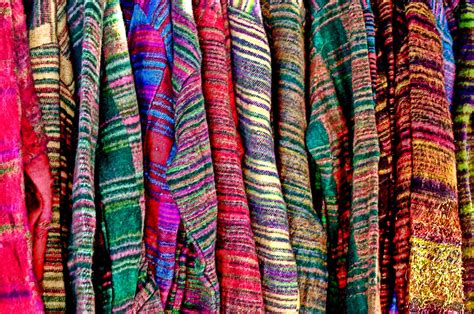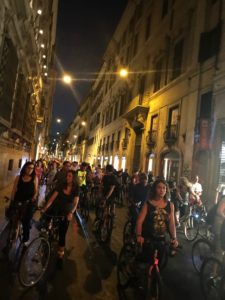What Should I Wear? (and life’s other big questions )
NOTE TO INHABIT YOUR DREAMS READERS: Greetings from Catalunya! Before beginning this blog post, I want to explain what happened about a week ago. This website mysteriously disappeared. My trusted web manager, Margie Baxley of Geek Websites, was able to restore it from backup. That auto-generated a mailing and you received an old blog post from me (and IggyMo), written about Girona’s annual Temps de Flors event almost a year ago. Unfortunately, like so much that was, the event was canceled this year due to Covid-19 and the general lockdown in Spain, in its 9th week as of this writing. I apologise for any confusion and hope you enjoy this light-hearted piece I wrote a while back but hadn’t yet published. I welcome your comments and look forward to hearing from you! With love, Aysha
I love textiles… textures, colors, patterns, and clothing styles from many cultures and eras. Lucky for me, I also love second-hand stores and charity shops, so I can indulge in occasional “shopping therapy,” usually without spending more than a lunch out, and easily acquire and give away whole wardrobes. But acquiring clothes isn’t the problem.
I’ve had plenty of clothes in my life, as I’m guessing you have too.
I once lived in the same house for 10 years and collected all manner of clothing and accessories to fill a glorious walk-through closet, the size of a small bedroom. It had built-in closet organizers — bars of varying heights, drawers, shelves, places for scarfs and pendants, belts, bags, shoes, even hats! I was so organized that I even used hangars of the same size and color so it looked uniformly fabulous. And this before Marie Kondo was out of diapers. So, organization was not the problem.
But some mornings, nay most mornings, I’d stand naked amid all these marvelously organized pieces of colorful cloth, and stare in total bewilderment… often for an embarrassing and disconcertingly long time.

Now, stating the obvious: to have this “problem” of what to wear is a sign of great privilege, worthy of appreciation and not to be taken too seriously, lest we forget that underneath this game of dress-up, we are all naked apes.
This reality check aside, for those of us with closets full of colors, patterns, textures and styles of dresses, skirts, pants, shorts, shirts, blouses, sweaters, jackets, from casual to formal and season specific, plus undergarments and all manner of accessories, the perennial and often overwhelming challenge, is not only, “What should I wear?” but
What can I wear?
What fits?
What looks good on me?
And what matches the fabulous hand-embroidered bellbottoms from Mexico I’ve never worn?
Being unable to quickly and easily answer these questions-to-self wastes a lot of time and psychic energy, and can even evoke emotions of despair and self-loathing.
Is there not some madness in this dilemma? And does it not speak to the ways we may have so complicated our lives that making clear and simple decisions becomes a source of anxiety rather than joy?
Eight years ago I embarked on an uncharted journey into an uncertain future, with no known closets. I divested myself of all possessions except what would fit into three suitcases (two large, one carry-on). Saying goodbye to nearly everything and everyone was like a conscious death, and the well-worn maxim, “You can’t take it with you,” played a mournful but strangely liberating refrain.
In deciding which clothes, shoes and accessories to bring, I realized the answer to “what to wear?” lay in coordinated outfits.
The significance of clothing
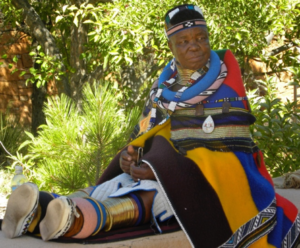
But before getting into details of applying “coordinating principles” to your wardrobe, let’s consider the scope of the significance of clothing. The story of humanity can be tracked by its story. From grasses and fronds to animal skins and furs; from the discovery of silk and dyes to the cultivation of animals, cotton and fibers; from the invention of needles-and-thread to looms, the cotton gin, mechanized production, synthetics and an online global marketplace. The fabrics with which we cloth our bodies connect us both to history, and to our present, complex world.
I’d like to continue musing about our relationship to clothing:
Why is what you wear important?
How can you have a healthy, happy relationship with your wardrobe, and everything you own?
But first, here are three essential principles you must understand for choosing clothing and coordinating outfits that look and feel great.
Essential principles
- Your body type. There are four basic body types or shapes. It’s obvious which you are, and knowing this helps make choices about what styles of clothes generally look best on your type. No body type is better or worse than another; it’s simply about accentuating your best attributes and minimizing your less-than-best to create a balanced — and more attractive — look. For a basic understanding of body types and the best styles of clothing for each, click here.– Apple: (triangle downward) broader shoulders and bust, and narrower hips
– Pear: (triangle upward) hip measurements are greater than bust measurements
– Banana: (straight/rectangular) waist measurement is less than 9 inches smaller than the hip or bust measurement.
– Hour glass: (triangles opposing, facing in) hip and bust are almost of equal size, with a narrow waist.
This pear-shaped author’s note to Apple and Pear-shaped bodies: “skinny leg” pants are for skinny legs attached to skinny butts and waists. Also, if you are not tall, thin and fit, please don’t wear leggings without a top that comes to at least the middle of your thighs. If you have a waistline worth showing off, add a belt.
- Your personal style. Whether you know it or not, you already have a style. Of course, you can choose to change it, and often, as we age and/or our lifestyle changes, so does our style. There are many websites that explain this and offer quizzes and tips. Here’s one. This site also has sections on discovering your colors and building your wardrobe.
- Your best colors. Just because you like a color, or it’s what’s being pushed this season, does not mean it looks good with your skin tone and hair color, or that the cut is in your style. For example, last year’s summer yellows and winter grays were “the worst” for this olive-skinned-gold-jewelry-wearing woman. To learn more about what colors combine well, check out this site and see her Pinterest illustration.
Once you know what styles and colors work best with your body type, personality and lifestyle, it’s a lot easier to create outfits that take the mystery out of “What should I wear?”
Your Clothes Want To “Speak to You”
We tend to think about objects in our home as “just things,” but consider this: You chose each item, brought it home, gave it a place to live, are responsible for it and, in essence, are in relationship with it. So, what if you approached these things as if sentient beings, like a dog or cat, or even a friend?
Most fashion consultants use a standard objective approach to decluttering and organising a wardrobe with criteria like: if you haven’t worn it in a year, or it doesn’t fit now, or if it needs repairs, etc. This is not “wrong,” but it is solely cerebral, devoid of emotion, and takes no account of the relationship we have with our things. If they didn’t matter, they wouldn’t be in our life… and indeed, many things hold little appreciation by us and are best to bid “adios.”
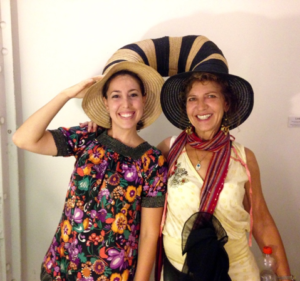
When you stand in the closet asking, “What should I wear?” do you listen for a reply? Seriously, I believe our clothes want to “speak” us. But, as with any relationship, we must spend time with them, touch them, hold them up and look at them.
You can ask them intelligent questions and listen open-heartedly to their answer. “Do you really like being on my body?” “Do you want to spend the whole day with me?” “Do you want to attend my business meeting… or walk around the lake, or my trip to the grocery store or to Rome?”
I’ve had clothes tell me, “I’m not comfortable on you.” “I fit you perfectly, but you obviously don’t like red pants.” “I know you haven’t worn me yet, but you bought me for a special occasion and I’d like to hang around longer and hope that occasion arises.”
Every day, once or more, we have this great luxury to decide which costume to don to reflect our sense of self… to our self (that beloved image in the mirror) and to the world in which we interact.
A closet full of clothes without outfits…
is like a scavenger hunt without clues!
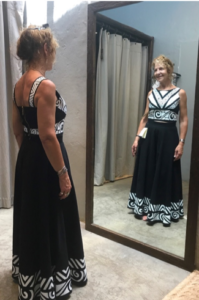
Ignoring the ever-shifting tides of fashion, I care about dressing comfortably in my colours and style, which could be call “Bohemian chic.” As a woman of a certain age, I’ve learned that now, more than ever, my daily “costumes” — whether at home or out-and-about — play huge role in how I feel. They are part of the theatre of my life.
I’ve been giving a lot of thought to the theatre of our lives, especially since entering my “Third Act,” (you can read about the new focus of my work), but most poignant is that as long as we are alive we are always on stage… scripting, designing, directing, producing and starring in this unique improvisational show.
The challenge of having a closet full of clothes and “nothing to wear” is not a lack of imagination. It’s a lack of curation.
The challenge of having a closet full of clothes and “nothing to wear”, or wearing the same clothes again and again, is not a lack of imagination. It’s a lack of curation, defined as “the action or process of selecting, organizing, and looking after the items in a collection or exhibition.” To wisely curate a collection, we must know what it’s about — the theme, the focus and the messages and emotions we hope to convey, to ourselves and whomever we encounter.
Curating our wardrobe is part of curating every aspect of our lives — from the food we buy and how we prepare it, to the way we arrange and decorate our spaces, to the information, people and activities to which we choose to give our time, attention and care. (Related to this subject, I recommend this free eBook by Jan H. Croteau, Hanging With Art: Make Every Room Extraordinary).
Ultimately, the question, “What should I wear?”, also begs the bigger life questions of self-identity and definition, like,
“What do I love?”
“What do I value?”
“What gives me joy?”
Although each of us must answer these questions for herself, not everyone has the time, interest or confidence to design and coordinate their wardrobe, living spaces, or healthy regimes; ergo the demand for services of designers, consultants and coaches who can help curate what we have to work with, maximising and exhibiting it to its personal and public best.
If you’ve read this far…
Thank you. I’ve covered a lot of ground here. It seems no matter what challenges we have — from the seemingly mundane, like how you dress, to more pressing matters like health, relationships, money — they all offer opportunities for greater self-knowing, and the satisfying expression of our most kind and compassionate selves.
I’d love if you’d leave a comment, even if just to let me know you’ve spent time with me here.
May I help?
If you’d like me to write more about any of the aspects covered in this article, email me or mention in a comment. If I may offer any help to you or a friend, contact me to schedule a free 30-minute coaching conversation. I’d love to hear from you!
“Aysha Griffin is a much-acclaimed coach who can help you to grow a business, start or complete a creative project, get a handle on your finances or, yes, curate your wardrobe. And to make it fun, you can do it via live video connection.” — Judith Fein
